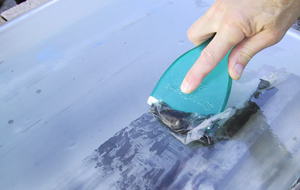
Cleaning former coat
Glass used as printing matrix for collotype having the advantage to be able to be almost reused infinitely (until accidental break), it ensues from it requires it to have to clean them before every new preparation.
Removal of the worn gelatin :
Method at sodium hypochlorite and at hydrogen peroxide :
- Moisten the glass plate in some tepid water rather during a quarter of an hour or more.
- Take out the plate. Put gloves. Pour above some pure sodium hypochlorite or pure hydrogen peroxide (in 130 volumes – 35 %). Spread with a sponge. Little by little the former gelatin dissolved. Put back of the pure solution to reactivate. Rub with a scouring pad to remove well any track of gelatin.
- Rinse abundantly in the clear water. The result is rather fast and very good.
Method in alkaline salts :
- Dive into a bath of tepid water and caustic soda or washing soda during one hour or two or more (very good results and not dangerous).
- Unstick then the gelatin by means of a spatula, then scratch edges with a pumice (at the good hardware dealers – white color). End the cleaning with a soft abrasive plug, the kind of those used to do the dishes, with some water.
- Rinse perfectly and let dry.
Method to fluorhydrique acid (dangerous!) :
- Prepare the following mixture: (10cc acid fluorhydrique in 40 ° for 1 liter of water): For a dry plate, put inflating the gelatin of the plate in the water before pour the fluorhydrique acid.
- We pour the preparation on the plate. The gelatin quickly blisters.
- We scrape with a spatula the coat which lifts up itself in a single film.
- Rinse in the water and scrape edges in the pumice. Rinse well in the clear water
Noted : this technique in the fluorhydrique acid was collectively used for the lamination of glass negative formerly used there collotype, because she allows the complete and quasi-immediate unsticking of all the coat, without altering it. The film establishing the negative could easily have returned.